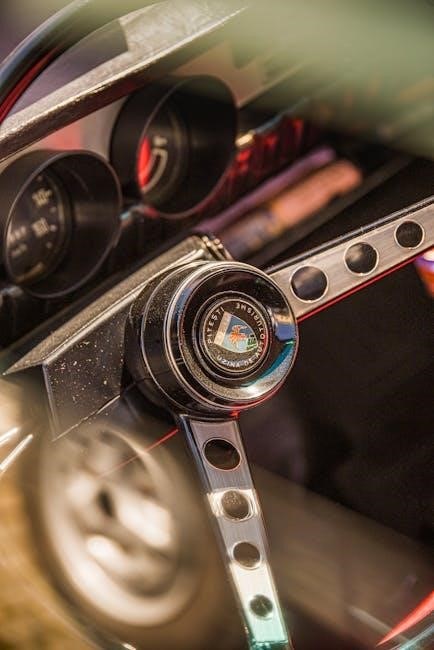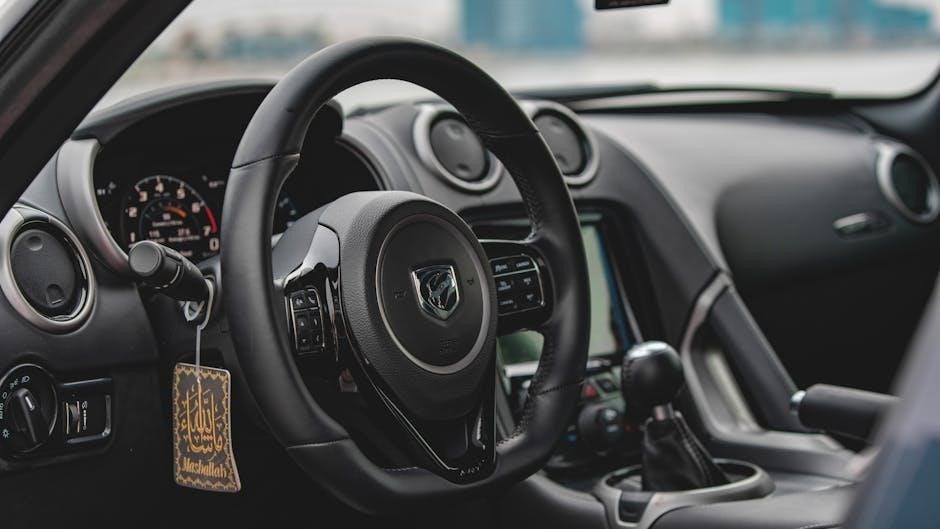
information and resources available online today always․
Definition of Steering System
A steering system is a complex mechanism that enables a vehicle to change direction in response to driver input․ The system consists of a series of components that work together to transmit the driver’s input to the wheels‚ allowing the vehicle to turn and maneuver․ According to online resources‚ a steering system is a critical component of a vehicle’s overall safety and performance․ The definition of a steering system encompasses not only the mechanical components but also the underlying principles that govern its operation․ The system’s primary function is to provide a smooth and responsive interface between the driver and the vehicle‚ allowing for precise control and maneuverability․ By understanding the definition of a steering system‚ drivers and mechanics can better appreciate the importance of proper maintenance and repair to ensure optimal vehicle performance․ The steering system plays a vital role in vehicle control and safety․

Types of Steering Systems
Steering systems are classified into different types using
various
criteria and methods always online․
Manual Steering System
A manual steering system is a type of steering system that requires the driver to exert physical effort to turn the wheels of a vehicle․ This system uses a combination of mechanical linkages and a steering gearbox to transmit the driver’s input to the wheels․ The manual steering system is commonly used in older vehicles and is known for its simplicity and reliability․ The system consists of a steering wheel‚ steering column‚ and a series of linkages that connect to the wheels․ The driver’s input is transmitted through the steering column to the steering gearbox‚ which then turns the wheels․ The manual steering system is often preferred by driving enthusiasts who enjoy the tactile feedback and control it provides․ Additionally‚ manual steering systems are generally less expensive to maintain and repair than power-assisted steering systems․ Overall‚ the manual steering system is a fundamental component of many vehicles․
Power-Assisted Steering System
The power-assisted steering system is a type of steering system that uses hydraulic or electric power to assist the driver in turning the wheels․ This system is designed to reduce the amount of physical effort required to steer a vehicle‚ making it easier to maneuver and control․ The power-assisted steering system consists of a power steering pump‚ a steering gearbox‚ and a series of hydraulic lines and hoses․ The system is activated when the driver turns the steering wheel‚ and it provides additional power to the steering gearbox to turn the wheels․ The power-assisted steering system is commonly used in modern vehicles and is known for its ease of use and reliability․ It is also designed to provide a smoother and more comfortable driving experience‚ with less vibration and noise․ Overall‚ the power-assisted steering system is a valuable component of many modern vehicles․

Components of Steering System
Steering system components include various parts like gears and
linkages
that work together to facilitate smooth vehicle movement always online today․
Steering Wheel
The steering wheel is a crucial component of the steering system‚ allowing drivers to control the direction of their vehicle with ease and precision‚ using a circular wheel that rotates on a central axis‚ typically mounted on a steering column․ The steering wheel is connected to the steering gearbox‚ which converts the rotational motion of the wheel into linear motion‚ ultimately turning the vehicle’s wheels․ Various features such as traffic indicator switches‚ light switches‚ and wiper switches are often integrated into the steering wheel for convenience and accessibility․ Modern steering wheels may also include additional features like cruise control‚ audio controls‚ and phone connectivity‚ enhancing the overall driving experience and providing a more comfortable and enjoyable ride for drivers․ The design and functionality of the steering wheel have evolved significantly over time‚ with advancements in technology and materials leading to improved performance and safety․
Steering Linkage
The steering linkage is a critical component of the steering system‚ comprising a series of interconnected parts that transmit the rotational motion of the steering wheel to the wheels of the vehicle․ This complex system includes components such as the pitman arm‚ ball joints‚ drag link‚ steering arm‚ spindle‚ tie rod‚ and kingpin assembly‚ all working together to provide precise control and stability․ The steering linkage is designed to withstand the stresses and strains of driving‚ while also providing a smooth and responsive steering experience․ By converting the rotational motion of the steering wheel into linear motion‚ the steering linkage enables the vehicle to change direction quickly and efficiently․ The steering linkage plays a vital role in maintaining vehicle stability and control‚ and its proper functioning is essential for safe and enjoyable driving․ Proper maintenance of the steering linkage is necessary to ensure optimal performance․

Boat Steering System
Boat steering system uses mechanical linkages and cables to control direction of boat movement always using
relevant
online information․
Types of Boat Steering System
There are several types of boat steering systems‚ including cable steering‚ hydraulic steering‚ and electric steering․ Each type has its own unique characteristics and advantages․ Cable steering systems use cables to connect the steering wheel to the rudder‚ while hydraulic steering systems use fluid pressure to transmit the steering motion․ Electric steering systems‚ on the other hand‚ use electric motors to control the rudder․ The choice of steering system depends on the size and type of boat‚ as well as the personal preference of the operator․ Some boats may also have additional steering systems‚ such as autopilot or trim tabs‚ to enhance their maneuverability and stability․ Overall‚ the type of boat steering system used can have a significant impact on the boat’s handling and performance․ The steering system is a critical component of a boat!
Differences between Boat and Car Steering
The main difference between boat and car steering is the way the steering motion is transmitted to the vehicle․ In a car‚ the steering motion is transmitted to the front wheels‚ whereas in a boat‚ the steering motion is transmitted to the rear of the boat‚ typically through a rudder or propeller․ This fundamental difference affects the way the vehicle handles and responds to steering input․ Additionally‚ boats are often more sensitive to steering input due to their smaller size and lower friction with the water․ The steering system of a boat must also be designed to withstand the corrosive effects of water and to operate effectively in a variety of water conditions․ Overall‚ the unique characteristics of boat steering require a distinct approach to steering system design and operation‚ differing from that of cars․ This affects the boat’s maneuverability and stability․

Importance of Steering System
Steering system is crucial for vehicle safety and control using
various
types of systems always effectively․
Role of Steering System in Vehicle Control
The steering system plays a vital role in vehicle control‚ allowing drivers to navigate roads safely and efficiently․ Using a combination of mechanical and hydraulic components‚ the steering system transmits the driver’s input to the wheels‚ enabling smooth and precise movement․ The system’s effectiveness is critical to preventing accidents and ensuring a comfortable driving experience․ A well-designed steering system can also improve vehicle stability and handling‚ particularly during high-speed maneuvers or emergency situations․ Furthermore‚ the steering system’s role in vehicle control is closely tied to the overall performance and safety of the vehicle‚ making it a crucial aspect of automotive design and engineering․ By understanding the role of the steering system‚ drivers and manufacturers can work together to create safer and more efficient vehicles․ The steering system’s importance cannot be overstated‚ and its impact on vehicle control is significant․
Evolution of Steering Systems
The evolution of steering systems has been a gradual process‚ with significant advancements in technology and design․ Over the years‚ steering systems have transitioned from manual to power-assisted and eventually to electronic power steering․ This progression has led to improved steering precision‚ reduced driver fatigue‚ and enhanced overall vehicle safety․ The introduction of new materials and manufacturing techniques has also enabled the development of more efficient and reliable steering systems․ As the automotive industry continues to advance‚ it is likely that steering systems will become even more sophisticated‚ incorporating advanced technologies such as autonomous driving and artificial intelligence․ The evolution of steering systems is a testament to human innovation and the pursuit of excellence in automotive engineering‚ with a focus on creating safer‚ more efficient‚ and more enjoyable driving experiences․ New developments are expected to further transform the steering system landscape․